机械工程专业英语施平没翻译课文补充
- 格式:doc
- 大小:35.75 KB
- 文档页数:19
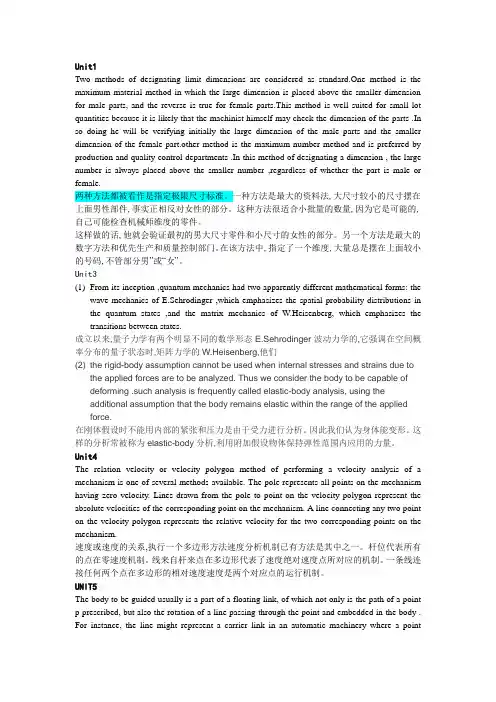
Unit1Two methods of designating limit dimensions are considered as standard.One method is the maximum material method in which the large dimension is placed above the smaller dimension for male parts, and the reverse is true for female parts.This method is well suited for small lot quantities because it is likely that the machinist himself may check the dimension of the parts .In so doing he will be verifying initially the large dimension of the male parts and the smaller dimension of the female part.other method is the maximum number method and is preferred by production and quality control departments .In this method of designating a dimension , the large number is always placed above the smaller number ,regardless of whether the part is male or female.两种方法都被看作是指定极限尺寸标准。
一种方法是最大的资料法,大尺寸较小的尺寸摆在上面男性部件,事实正相反对女性的部分。

Metal-Cutting ProcessMetal-cutting processes are extensively used in the manufacturing industry.They are characterized by the fact that the size of the original workpiece is sufficiently large that the final geometry can be circumscribed by it, and that the unwanted material is removed as chips, particles, and so on. The chips are a necessary means to obtain the desired tolerances, and surfaces. The amount of scrap may vary from a few percent to 70%--80% of the volume of the original work material.Owing to the rather poor material utilization of the metal-cutting processes, the anticipated scarcity of materials and energy, and increasing costs, the development in the last decade has been directed toward an increasing application of metal-forming processes. However, die costs and the capital cost of machines remain rather high; consequently, metal-cutting processes are, in many cases, the most economical, in spite of the high material waste, which only has value as scrap. Therefore, it must be expected that the material removal processes will for the next few years maintain their important position in manufacturing. Furthermore, the development of automated production systems has progressed more rapidly for metal-cutting processes than for metal-forming processes.In metal-cutting processes, the imprinting of information is carried out by a rigid medium of transfer, which is moved relative to the workpiece, and the mechanical energy is supplied through the tool. The final geometry is thus determined from the geometry of the tool and the pattern of motions of the tool and the workpiece. The basic process is mechanical: actually, a shearing action combined with fracture.As mentioned previously, the unwanted material in metal-cutting processes is removed by a rigid cutting tool, so that the desired geometry, tolerances, and surface finish are obtained. Examples of processes in this group are turning, drilling, reaming, milling, shaping, planning, broaching, grinding, honing, and lapping.Most of the cutting or machining processes are based on a two-dimensional surface creation, which means that two relative motions are necessary between the cutting tool and the work material. These motions are defined as the primary motion, which h mainly determines the cutting speed, and the feed motion, which provides the cutting zone with new material.In turning the primary motion is provided by the rotation of the workpiece, and in planning it is provided by the translation of the table; in turning the feed motion is a continuous translation of the tool, and in planning it is an intermittent translation of the tool.《机械工程专业英语》哈尔滨工业大学出版社施平金属切削加工金属切削加工在制造业中等到了广泛的应用。
![机械工程专业英语教程(第2版)[施平主编][翻译]_lesson19](https://uimg.taocdn.com/1d59be3367ec102de2bd8909.webp)
Gear Materials (Reading Material)齿轮材料(阅读材料)Gears are manufactured from a wide variety of materials, both metallic as well as nonmetallic.齿轮由多种种类的材料制造,包括金属材料和非金属材料。
As is the case with all materials used in design, the material chosen for a particular gear should be the cheapest available that will ensure satisfactory performance.在设计中可以使用多种材料的情况下,对于特定齿轮,应当做到选用满足使用要求下的最便宜的材料。
Before a choice is made, the designer must decide which of several criteria is most important to the problem at hand.在作出选择前,设计师必须决定在众多设计准则中哪个是当前最重要的。
If high strength is the prime consideration, a steel should usually be chosen rather than cast iron.如果高强度是第一要考虑的因素,通常就选择钢材而不选择铸铁。
If wear resistance is the most important consideration, a can be made, for problems involving noise reduction, nonmetallic. Materials perform better than metallic ones.如果耐磨性是最重要的因素,可以选用非金属材料要比金属材料更好,同时也可以解决降低噪声的问题。
![机械工程专业英语教程(第2版)[施平主编][翻译]_lesson1](https://uimg.taocdn.com/5728f673a417866fb84a8e09.webp)
Basic Concept in MechanicsThe branch of scientific analysis which deals with motions , time , and forces is called mechanics and is made up of two parts , statics and dynamics , Statics deals with the analysis of stationary systems , i.e. , those in which time is not a factor , and dynamics deals with systems which change with time .对运动、时间和作用力做出科学分析的分支称为力学。
它由静力学和动力学两部分组成。
静力学对静止系统进行分析,即在其中不考虑时间这个因素,动力学对随时间而变化的系统进行分析。
When a number of bodies are connected together to form a group or system , the forces of action and reaction between any two of the connecting bodies are called constraint forces . These forces constrain the bodies to behave in a specific manner . Forces external to this system of bodies are called applied forces .当一些物体连接在一起形成一个组合体或者系统时,任何两个相连接的物体之间的作用力和反作用力被称为约束力。
这些力约束着各个物体,使其处于特定的状态。
从外部施加到这个物体的系统的力被称为外力。
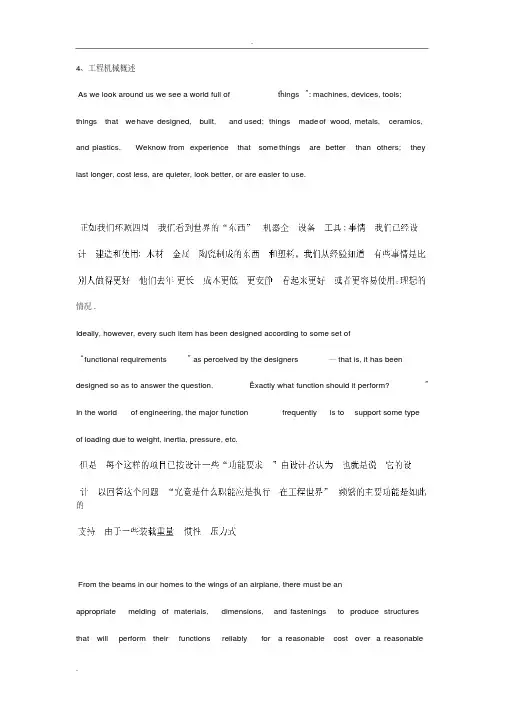
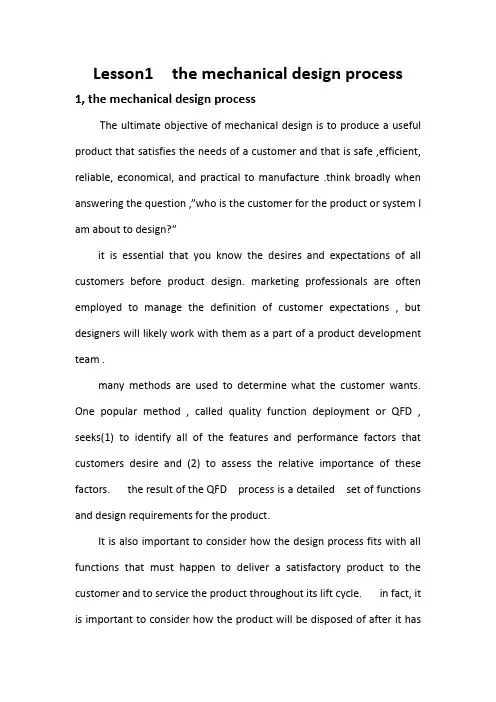
Lesson1 the mechanical design process 1, the mechanical design processThe ultimate objective of mechanical design is to produce a useful product that satisfies the needs of a customer and that is safe ,efficient, reliable, economical, and practical to manufacture .think broadly when answering the question ,”who is the customer for the product or system I am about to design?”it is essential that you know the desires and expectations of all customers before product design. marketing professionals are often employed to manage the definition of customer expectations , but designers will likely work with them as a part of a product development team .many methods are used to determine what the customer wants. One popular method , called quality function deployment or QFD , seeks(1) to identify all of the features and performance factors that customers desire and (2) to assess the relative importance of these factors. the result of the QFD process is a detailed set of functions and design requirements for the product.It is also important to consider how the design process fits with all functions that must happen to deliver a satisfactory product to the customer and to service the product throughout its lift cycle. in fact, it is important to consider how the product will be disposed of after it hasserved its useful life . the total of all such function that affect the product is sometimes called the product realization process or PRP . some of the factors included in PRP are as follows:1 marketing functions to assess customer requirements2 research to determine the available technology that can reasonably be used in the product3 availability of materials and components that can be incorporated into the product4 product design and development5 performance testing6 documentation of the design7 vendor relationships and purchasing functions8 work-force skills9 physical plant and facilities available10 capability of manufacturing systems11production planning and control of production systems12production support systems and personnel13 quality systems requirements14 sales operations and time schedules15 cost targets and other competitive issues16 customer service requirements17 environmental concerns during manufacture , operation anddisposal of the product18 legal requirements19 availability of financial capitalCan you add to this list? You should be able to see that the design of a product is but one part of a comprehensive process. in this text, we will focus more carefully on the design process itself , but the producibility of designs must always be considered . this simultaneous consideration of product design and manufacturing process design is often called concurrent engineering.2 skills needed in mechanical designProduct engineers and mechanical designers use a wide range of skills and knowledge in their daily work . these skills and knowledge are included in the following :1sketching, technical drawing , and computer-aided design2 properties of materials, materials processing, and manufacturing processes3 applications of chemistry, such as corrosion protection, plating , and painting4 statics, dynamics, strength of materials , kinematics, and mechanisms5 fluid mechanics, thermodynamics, and heat transfer6 fluid power, the fundamentals of electrical phenomena, andindustrial controls7 experimental design and performance testing of materials and mechanical systems8 stress analysis9 specialized knowledge of the behavior of machine elements, such as gears, belt drives, chain drives, shafts, bearings, keys, splines, couplings, seals, spring, connections(bolted, riveted, welded, adhesive), electric motors, linear motion devices, clutches, and brakes10 creativity , problem solving ,and project management11 oral communication, listening, technical writing, and teamwork skills3 functions , design requirements and evaluation criteriaSection 1 emphasized the importance of carefully identifying the needs and expectations of the customer prior to beginning the design of a mechanical device. you can formulate these by producing clear , complete statements of functions, design requirements , and evaluation criteria:1 Functions tell us what the device must do , using general , nonquantitative statements that employ action phrases such as “to support a load”, “to lift a crate ”, “to transmit power”, or “to hold two structural members together”, etc2 Design requirements are detailed, usually quantitativestatements of expected performance levels, environmental conditions in which the device must operate, limitations on space or weight , or available materials and components that may be used3 Evaluation criteria are statements of desirable qualitative characteristics of a design that assist the designer in deciding which alternative design is optimum-that is , the design that maximizes benefits while minimizing disadvantagesTogether these elements can be called the specifications for the designMost designs progress through a cycle of activities are outlined in figure1.1. you should typically propose more than one possible alternative design concept. This is where creativity is exercised to produce truly novel designs .Each design concept must satisfy the functions and design requirements . a critical evaluation of the desirable features, advantages, and disadvantages of each design concept should be completed . then a rational decision analysis technique should use the evaluation criteria to decide which design concept is the optimum and , therefore , should be produced.Reading materialMechanical design is the process of designing and/or selecting mechanical components and putting them together to accomplish a desired function. Of course machine elements must be compatible ,must fit well together , and must perform safely and efficiently. The designer must consider not only the performance of the element being designed at a given time , but also the elements with which it must interface.To illustrate how the design of machine elements must be integrated with a larger mechanical design , let us consider the design of a speed reducer for the small tractor . suppose that,to accomplish the speed reduction ,you decide to design a double-reduction, spur gear speed reducer. You specify four gears , three shafts , six bearings, and a housing to hold the individual elements in proper relation to each other. The primary elements of the speed reducer are :1 the input shaft is to be connected to the power source, a gasoline engine whose output shaft rotates at 2000 rpm . a flexible coupling is to be employed to minimize difficulties with alignment .2 the first pair of gears, a and b ,causes a reduction in the speed of the intermediate shaft proportional to the ratio of the numbers of teeth in the gears. Gear b and c are both mounted to intermediate shaft and rotate at the same speed .3 a key is used at the interface between the hub of each gear and the shaft on which it is mounted to transmit torque between the gear and the shaft .4 the second pair of gears , c and d ,further reduces the speed of gear d and the output shaft to the range of 290 rpm to 295 rpm .5 the output shaft is to carry a chain sprocket.the chain drive ultimately is to be connected to the drive wheel of the tractor.6 each of the three shafts is supported by two ball bearings .making them statically determinate and allowing the analysis of forces and stresses using standard principles of mechanics.7 the bearings are held in a housing that is to be attached to the frame of the tractor . note the manner of holding each bearing so that the inner race rotates with the shaft while the outer race is held stationary.8 seals are on the input and output shafts to prohibit contaminants from entering the housing .9 details of how the active elements are to be installed , lubricated, and aligned are only suggested at this stage of the design process to demonstrate feasibility .one possible assembly process could be as follows.Start by placing the gearing the gears, keys, spacers, and bearings on their respective shaftsThen insert input shaft into its bearing seat on the left side of the housing.Insert the left end of intermediate shaft into its bearing seat whileengaging the teeth of gears a and b.Install the center bearing support to provide support for the bearing at the right side of input shaft.Install output shaft by placing its left bearing into the seat on the center bearing support while engaging gears c and d.Install the right side cover for the housing while placing the final two bearings in their seats.Ensure careful alignment of the shafts.Place gear lubricant in the lower part of housing .The arrangement of the gears, the placement of the bearings so that they straddle the gears , and the general configuration of the housing are also design decisions . the design process cannot rationally proceed until these kinds of decisions are made . when the overall design is conceptualized, the design of the individual machine elements in the speed reducer can proceed . you should recognize that you have already made many design decisions by rendering such a sketch . first, you choose spur gears rather than helical gears , a worm and worm gear , or bevel gears. in fact , other types of speed reduction devices –belt drives , chain drives, or many others—could be appreciate.1gearsfor the gear pairs ,you must specify the number of teeth in each gear ,the pitch (size) of the teeth , the pitch diameters, the face width ,and the material and its heat treatment . these specifications depend on considerations of strength and wear of the gear teeth and the motion requirements(kinematics ). You must also recognize that the gears must be mounted on shafts in a manner that ensures proper location of the gears, adequate torque transmitting capability from the gears to the shafts (as through keys ) and safe shaft design.2shaftshaving designed the gear pairs, next you will consider the shaft design . the shaft is loaded in bending and torsion because of the forces acting at the gear teeth . thus, its design must consider strength and rigidity , and it must permit the mounting of the gears and bearings . shafts of varying diameters may be used to provide shoulders against which to seat the gears and bearings. There may be keyseats cut into the shaft, the input and output shafts will extend beyond the housing to permit coupling with the engine and the drive axle . the type of coupling must be considered, as it can have a dramatic effect on the shaft stress analysis. Seals on the input and output shafts protect internal components.3bearingsdesign of the bearings is next. If rolling contact bearings are to be used , you will probably select commercially available bearings from a manufacturer’s catalog , rather than design a unique one . you mustfirst determine the magnitude of the loads on each bearing from the shaft analysis and the gear designs. The rotational speed and reasonable design life of the bearings and their compatibility with the shaft on which they are to be mounted must also be considered. For example , on the basis of the shaft analysis, you could specify the minimum allowable diameter at each bearing seat location to ensure safe stress levels . the bearing selected to support a particular part of the shaft ,then , must have a bore( inside diameter) no smaller than necessary. When a specific bearing is selected , the shaft at the bearing seat location and allowable tolerances must be specified ,according to the bearing manufacturer’s recommendations , to achieve proper operation and life expectancy of the bearing.。
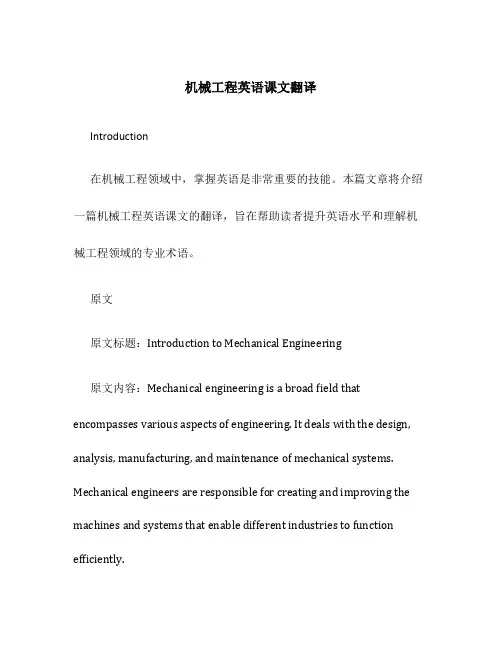
机械工程英语课文翻译Introduction在机械工程领域中,掌握英语是非常重要的技能。
本篇文章将介绍一篇机械工程英语课文的翻译,旨在帮助读者提升英语水平和理解机械工程领域的专业术语。
原文原文标题:Introduction to Mechanical Engineering原文内容:Mechanical engineering is a broad field that encompasses various aspects of engineering. It deals with the design, analysis, manufacturing, and maintenance of mechanical systems. Mechanical engineers are responsible for creating and improving the machines and systems that enable different industries to function efficiently.The field of mechanical engineering has a long history, dating back to ancient civilizations such as the Greeks and Egyptians. However, it wasn’t until the Industrial Revolution in the 18th century that mechanical engineering became a distinct discipline. This period saw the rise of factories and the need for efficient machines to drive industrial processes.Modern mechanical engineers work on a wide range of projects, from designing and constructing buildings to developing advanced robotics and aerospace systems. They utilize their knowledge of physics, mathematics, and materials science to analyze and solve complex engineering problems.翻译翻译标题:机械工程导论机械工程是一个包含各个工程学科的广泛领域。
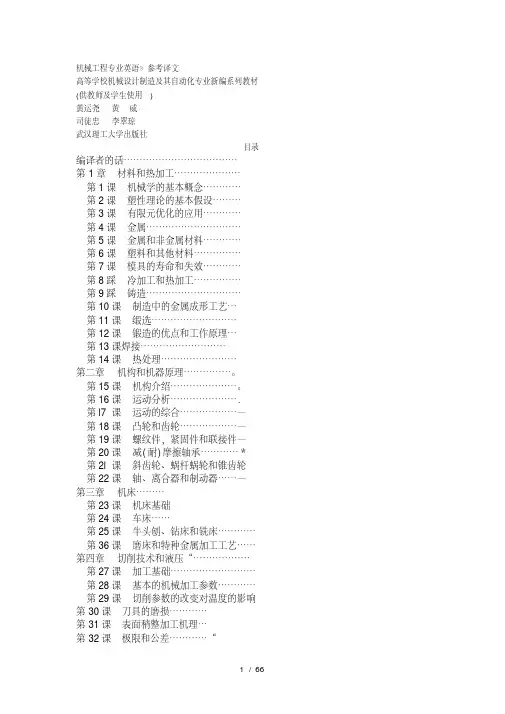
机械工程专业英语》参考译文高等学校机械设计制造及其自动化专业新编系列教材(供教师及学生使用)黄运尧黄威司徒忠李翠琼武汉理工大学出版社目录编译者的话………………………………第1章材料和热加工…………………第1课机械学的基本概念…………第2课塑性理论的基本假设………第3课有限元优化的应用…………第4课金属…………………………第5课金属和非金属材料…………第6课塑料和其他材料……………第7课模具的寿命和失效…………第8踩冷加工和热加工……………第9踩铸造…………………………第10课制造中的金属成形工艺…第11课缎选………………………第12课锻造的优点和工作原理…第13课焊接………………………第14课热处理……………………第二章机构和机器原理……………。
第15课机构介绍…………………。
第16课运动分析………………….第l7课运动的综合………………—第18课凸轮和齿轮………………—第19课螺纹件,紧固件和联接件—第20课减(耐)摩擦轴承…………*第2l课斜齿轮、蜗杆蜗轮和锥齿轮第22课轴、离合器和制动器……—第三章机床………第23课机床基础第24课车床……第25课牛头刨、钻床和铣床…………第36课磨床和特种金属加工工艺……第四章切削技术和液压“………………第27课加工基础………………………第28课基本的机械加工参数…………第29课切削参数的改变对温度的影响第30课刀具的磨损…………第31课表面稍整加工机理…第32课极限和公差…………“第33课尺寸控制和表面桔整”第34课自动央具设计………“第36课变速液压装置……………—…………—策37课电液伺服系统…………。
……………。
第五章机械电子技术………………………………第38课专家系统……。
…………………………第3D课建筑机器人………………………………第40课微机为基础的机器人模拟………………第41课机器人学的定义和机器入系统…………第42课微型计算机基础(1)……………………第43课微型计算机基础(x)……………………第44课可编程控制器……………………………第45课CAD/CAM计算机辅助设计与制造…第46课计算机数控和直接数控,CNC和DNC第47课加工过程的数控—………………………第48课柔性制造系统……………—……………第仍课交互式编程系统…………………………第50课在振动分析方面的计算机技术…………策51课压力传感器………………………………第52课反馈元件…………………—……………第53课现代按制理论概述………………………第54课管理上采取了新的措施—来自福持汽第六章英文科技文献和专利文献的查阅…………6.1 常见科技文献及其查阅………………………6.2 专利文献概述…………………………………第七章英文科拉论文写作…………………………7.1 标题与摘要写法………………………………7.2 正文(body)的组织与写法…………………7.3 致谢、附录及参考文献………………—……参考文献………………………………………………第1章材料和热加工机械学的基本概念功是力乘以该力作用在物体上佼物体移动的距离。
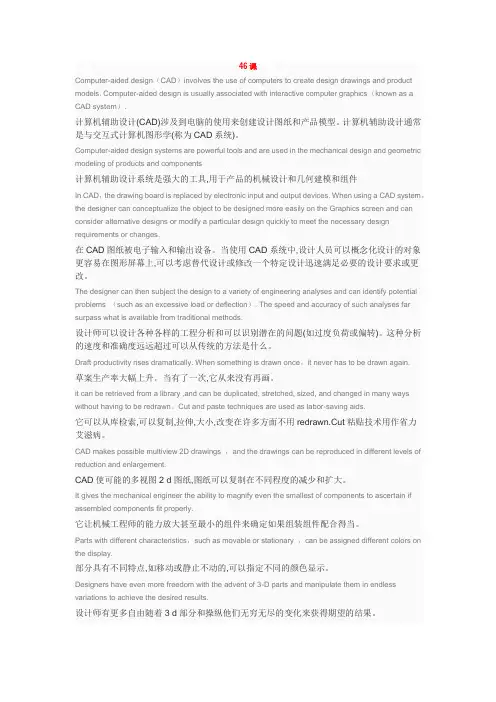
46课Computer-aided design(CAD)involves the use of computers to create design drawings and product models. Computer-aided design is usually associated with interactive computer graphics(known as a CAD system).计算机辅助设计(CAD)涉及到电脑的使用来创建设计图纸和产品模型。
计算机辅助设计通常是与交互式计算机图形学(称为CAD系统)。
Computer-aided design systems are powerful tools and are used in the mechanical design and geometric modeling of products and components计算机辅助设计系统是强大的工具,用于产品的机械设计和几何建模和组件In CAD,the drawing board is replaced by electronic input and output devices. When using a CAD system,the designer can conceptualize the object to be designed more easily on the Graphics screen and can consider alternative designs or modify a particular design quickly to meet the necessary design requirements or changes.在CAD图纸被电子输入和输出设备。
当使用CAD系统中,设计人员可以概念化设计的对象更容易在图形屏幕上,可以考虑替代设计或修改一个特定设计迅速满足必要的设计要求或更改。
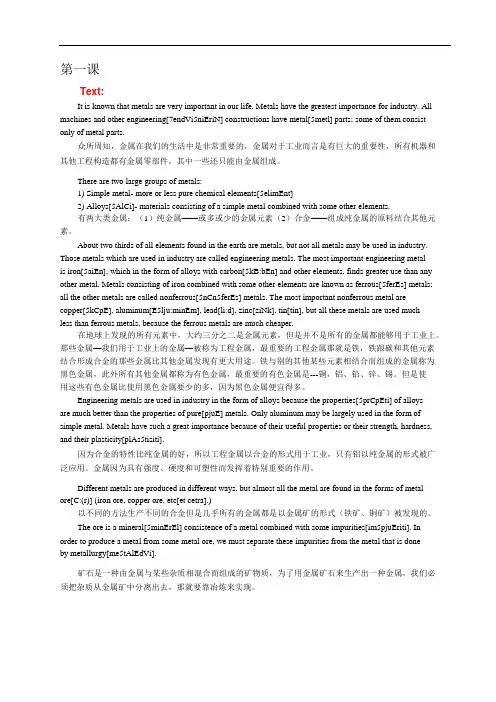
第一课Text:It is known that metals are very important in our life. Metals have the greatest importance for industry. All machines and other engineering[7endVi5niEriN] constructions have metal[5metl] parts; some of them consist only of metal parts.众所周知,金属在我们的生活中是非常重要的,金属对于工业而言是有巨大的重要性,所有机器和其他工程构造都有金属零部件,其中一些还只能由金属组成。
There are two large groups of metals:1) Simple metal- more or less pure chemical elements[5elimEnt]2) Alloys[5AlCi]- materials consisting of a simple metal combined with some other elements.有两大类金属:(1)纯金属——或多或少的金属元素(2)合金——组成纯金属的原料结合其他元素。
About two thirds of all elements found in the earth are metals, but not all metals may be used in industry. Those metals which are used in industry are called engineering metals. The most important engineering metalis iron[5aiEn], which in the form of alloys with carbon[5kB:bEn] and other elements, finds greater use than any other metal. Metals consisting of iron combined with some other elements are known as ferrous[5ferEs] metals; all the other metals are called nonferrous[5nCn5ferEs] metals. The most important nonferrous metal arecopper[5kCpE], aluminum[E5lju:minEm], lead[li:d], zinc[ziNk], tin[tin], but all these metals are used muchless than ferrous metals, because the ferrous metals are much cheaper.在地球上发现的所有元素中,大约三分之二是金属元素,但是并不是所有的金属都能够用于工业上。
![[新版]机械工程专业英语教程(第2版)[施平主编][翻译]_lesson12](https://uimg.taocdn.com/62824efc18e8b8f67c1cfad6195f312b3169eb4d.webp)
Spur GearsGears , defined as toothed members transmitting rotary motion from one shaft to another , are among the oldest devices and inventions of man . In about 2600 B.C. , the Chinese are known to have used a chariot incorporating a complex series of gears . Aristotle , in the fourth century B.C. , wrote of gears as if they were commonplace . In the fifteenth century A.D. , Leonardo da Vinci designed a multitude of devices incorporating many kinds of gears .齿轮,在最古老的设备和发明人中,被定义为通过轮齿将旋转运动从一根轴传递到另一根轴,大约在公元前2600年,中国人就知道用战车组成一系列复杂的齿轮系。
西元前四世纪,亚里士多德记述了齿轮就好像是他们司空见惯的一样。
在十五世纪,达芬奇设计了大量的包含各种各样齿轮的设备。
Among the various means of mechanical power transmission (including primarily gears , belts , and chains ) , gears are generally the most rugged and durable . Their power transmission efficiency is as high as 98 percent . On the other hand , gears are usually more costly than chains and belts . As would be expected , gear manufacturing costs increase sharply with increased precision -- as required for the combination of high speeds and heavy loads , and for low noise levels . ( Standard tolerances for various degrees of manufacturing precision have been established by the AGMA , American Gear Manufacturers Association. )在众多的机械传动方式中(包括齿轮传动,带传动,链传动),一般来说,齿轮是最经久耐用的,它的能量传递效率高达98%。
机械工程英语原文+翻译完整版第一单元Types of Materials材料的类型Materials may be grouped in several ways. Scientists often classify materials by their state: solid, liquid, or gas. They also separate them into organic (once living) and inorganic (never living) materials.材料可以按多种方法分类。
科学家常根据状态将材料分为:固体、液体或气体。
他们也把材料分为有机材料(曾经有生命的)和无机材料(从未有生命的)。
For industrial purposes, materials are divided into engineering materials or nonengineering materials. Engineering materials are those used in manufacture and become parts of products.就工业效用而言,材料被分为工程材料和非工程材料。
那些用于加工制造并成为产品组成部分的就是工程材料。
Nonengineering materials are the chemicals, fuels, lubricants, and other materials used in the manufacturing process, which do not become part of the product.非工程材料则是化学品、燃料、润滑剂以及其它用于加工制造过程但不成为产品组成部分的材料。
Engineering materials may be further subdivided into: ①Metal ②Ceramics ③Composite ④Polymers, etc.工程材料还能进一步细分为:①金属材料②陶瓷材料③复合材料④聚合材料,等等。
施平机械工程专业英语教程Introduction to Mechanical EngineeringChapter 1: Introduction to Mechanical Engineering- Definition and scope of mechanical engineering- Historical background and evolution of the field- Overview of various disciplines within mechanical engineering Chapter 2: Mechanics- Principles of mechanics, including statics and dynamics- Laws of motion and their applications- Analysis of forces and moments in mechanical systems Chapter 3: Thermodynamics- Basic concepts and laws of thermodynamics- Energy and heat transfer in mechanical systems- Analysis of thermodynamic cycles and processesChapter 4: Materials Science and Engineering- Properties and behavior of materials used in mechanical engineering- Material testing and characterization methods- Selection of materials for specific applicationsChapter 5: Fluid Mechanics- Fundamentals of fluid mechanics- Analysis of fluid flow and pressure distribution- Applications of fluid mechanics in mechanical systems Chapter 6: Heat Transfer- Modes of heat transfer (conduction, convection, radiation)- Heat transfer analysis and calculations- Applications of heat transfer in mechanical systemsChapter 7: Energy Conversion and Power Systems- Energy conversion principles and devices- Analysis of power generation systems- Renewable energy sources and sustainabilityChapter 8: Machine Design and Control Systems- Design principles and methodologies for mechanical systems- Control systems and automation in mechanical engineering- Analysis and optimization of machine componentsChapter 9: Manufacturing Processes- Various manufacturing processes and methodologies- Machining, forming, casting, and joining processes- Quality control and inspection in manufacturingChapter 10: Engineering Ethics and Professionalism- Ethical considerations in engineering practice- Professional responsibility and accountability- Society and the engineer's role in sustainable development Chapter 11: Career Opportunities in Mechanical Engineering- Overview of career options and paths in mechanical engineering - Skills and qualities desired by employers- Professional organizations and resources for career advancement Chapter 12: Emerging Technologies in Mechanical Engineering- Trends and developments in the field of mechanical engineering - Introduction to advanced technologies like robotics, nanotechnology, and artificial intelligence- Potential impact of these technologies on the future of mechanical engineering.。
机械工程专业英语教程第一课:机械工程简介Introduction to Mechanical EngineeringSection 1: OverviewMechanical engineering is a diverse and dynamic field that encompasses the design, development, and operation of machinery, structures, and systems. This branch of engineering plays a crucial role in various industries, including automotive, aerospace, manufacturing, and energy.Section 2: Responsibilities and SkillsAs a mechanical engineer, your responsibilities will include designing and analyzing mechanical systems, conducting tests and experiments, and supervising the manufacturing process. You will also need to have a strong understanding of physics, mathematics, and computer-aided design (CAD). Additionally, problem-solving skills, attention to detail, and the ability to work well in teams are essential.Section 3: Career OpportunitiesA degree in mechanical engineering can open up a wide range of career opportunities. You could work in research and development, product design, manufacturing, or projectmanagement. Mechanical engineers are in demand in almost every industry, ensuring a stable and rewarding career path.Section 4: University CoursesTo become a mechanical engineer, it is essential to pursue a degree in mechanical engineering from a reputable university. The curriculum typically includes courses in engineering principles, materials science, thermodynamics, fluid mechanics, and mechanical design. Additionally, practical training through internships or cooperative education programs is crucial for gaining hands-on experience.Section 5: ConclusionMechanical engineering offers a challenging and rewarding career for those with a passion for solving problems and a desire to create innovative solutions. With the right education and skills, you can embark on a successful journey in the field of mechanical engineering. Remember, the possibilities are endless in this ever-evolving discipline.第二课:机械设计基础Fundamentals of Mechanical DesignSection 1: IntroductionIn this lesson, we will explore the fundamentals of mechanical design. Mechanical design involves the creation and development of physical systems and components that meet specific requirements and specifications. This processrequires a deep understanding of materials, mechanics, and engineering principles.Section 2: Design ProcessThe design process typically follows a systematic approach that includes several stages. These stages include problem identification, conceptual design, detailed design, manufacturing, and testing. Each stage involves various activities such as brainstorming, prototyping, and evaluation.Section 3: Design ConsiderationsDuring the design process, there are several important considerations to keep in mind. These include functionality, efficiency, reliability, safety, and cost-effectiveness. It is also crucial to consider the environmental impact and sustainability of the design.Section 4: Tools and SoftwareTo aid in the design process, engineers use various tools and software. Computer-aided design (CAD) software allows for precise modeling and simulation of mechanical systems. Finite element analysis (FEA) software helps in analyzing the structural integrity and performance of designs.Section 5: Case StudyTo further understand the application of mechanical design principles, we will examine a case study. This real-world example will demonstrate how the design process isimplemented to solve a specific problem and achieve desired outcomes.Section 6: ConclusionMechanical design is a critical aspect of mechanical engineering. It requires a combination of creativity, technical knowledge, and attention to detail. By mastering the fundamentals of mechanical design, you will be well-equippedto tackle complex challenges and contribute to the development of innovative solutions.以上是《机械工程专业英语教程》的课文翻译。
机械工程专业英语参考译文机械工程专业英语参考译文机械工程是一门涉及设计、制造、控制和维护机械系统的学科,涉及到许多不同的领域,包括制造业、航空航天、汽车、能源和医疗设备等。
机械工程专业英语是机械工程领域中非常重要的语言工具,以下是一些常见的机械工程专业英语词汇和短语:1. Machine Tools - 机器工具Machine tools are tools that are used to perform precision machining operations on materials. They include drills, mills, lathes, routers, and other tools that are used to create precision parts and assemblies.2. Material - 材料Material is any substance that is in a solid, liquid, or gas state. It can be made from a variety of materials, such as metals, ceramics, plastics, and papers. In engineering, material refers to the physical and chemical properties of a material that determine its behavior in a particular application.3. Design - 设计Design refers to the process of creating a plan or concept for a particular object or system. It involves analyzing the needs and requirements of a particular application, and thenusing geometry, math, and other tools to create a visual representation of the object or system.4. Tolerance - 公差Tolerance is the allowance for error or variation that is allowed in a manufacturing process. It is the amount of variation that is acceptable in a product or component before it is considered to be within specification. In engineering, tolerance refers to the accuracy with which a component or system is designed to operate.5. machinist - 机械工程师Machinist is a professional in the field of mechanical engineering who specializes in the design, construction, and maintenance of machine tools. Machinists typically work in manufacturing plants, tool and die shops, and other industrial settings.6. lathe - 车床Lathe is a machine tool that is used to machine rotationally symmetric objects, such as shafts, gears, and camshafts. It includes a bed, a turret, and a spindle that rotates the workpiece around its axis.7. milling machine - 铣床Milling machine is a machine tool that is used for precisionmachining of materials. It includes a spindle that rotates a cutting tool, which can be a carbide or other hard tool, around its axis. milling machines are commonly used for machining metals, ceramics, and other materials.8. precision - 精度Precision refers to the accuracy and reliability of a machine tool or other industrial equipment. It is the ability of a tool to produce parts or assemblies that are within specified tolerance limits, and is often measured in units of accuracy, such as microns or inches.9. toolholder - 刀具夹具Toolholder is a device that is used to hold a cutting tool in a machine tool. It typically includes a base, a support surface, and a nose that supports the tool at a desired angle and distance from the workpiece.10. fastener - 紧固件Fastener is any device that is used to join two or more objects together. They include nuts, bolts, screws, pins, and other devices that are used to secure components together. In engineering, fasteners refer to the materials and techniques used to install and secure fasteners.以上是一些机械工程专业英语词汇和短语的示例,这些词汇和短语在机械工程领域中非常重要,掌握它们可以帮助机械工程专业的学生和从业者更好地理解和应用机械工程知识。
2、应力和应变在任何工程结构中独立的部件或构件将承受来自于部件的使用状况或工作的外部环境的外力作用。
如果组件就处于平衡状态,由此而来的各种外力将会为零,但尽管如此,它们共同作用部件的载荷易于使部件变形同时在材料里面产生相应的内力。
有很多不同负载可以应用于构件的方式。
负荷根据相应时间的不同可分为:(a)静态负荷是一种在相对较短的时间内逐步达到平衡的应用载荷。
(b)持续负载是一种在很长一段时间为一个常数的载荷, 例如结构的重量。
这种类型的载荷以相同的方式作为一个静态负荷; 然而,对一些材料与温度和压力的条件下,短时间的载荷和长时间的载荷抵抗失效的能力可能是不同的。
(c)冲击载荷是一种快速载荷(一种能量载荷)。
振动通常导致一个冲击载荷, 一般平衡是不能建立的直到通过自然的阻尼力的作用使振动停止的时候。
(d)重复载荷是一种被应用和去除千万次的载荷。
(e)疲劳载荷或交变载荷是一种大小和设计随时间不断变化的载荷。
上面已经提到,作用于物体的外力与在材料里面产生的相应内力平衡。
因此,如果一个杆受到一个均匀的拉伸和压缩,也就是说, 一个力,均匀分布于一截面,那么产生的内力也均匀分布并且可以说杆是受到一个均匀的正常应力,应力被定义为应力==负载 P /压力 A,因此根据载荷的性质应力是可以压缩或拉伸的,并被度量为牛顿每平方米或它的倍数。
如果一个杆受到轴向载荷,即是应力,那么杆的长度会改变。
如果杆的初始长度L和改变量△L已知,产生的应力定义如下:应力==改变长△L /初始长 L因此应力是一个测量材料变形和无量纲的物理量 ,即它没有单位;它只是两个相同单位的物理量的比值。
一般来说,在实践中,在荷载作用下材料的延伸是非常小的, 测量的应力以*10-6的形式是方便的, 即微应变, 使用的符号也相应成为ue。
从某种意义上说,拉伸应力与应变被认为是正的。
压缩应力与应变被认为是负的。
因此负应力使长度减小。
当负载移除时,如果材料回复到初始的,无负载时的尺寸时,我们就说它是具有弹性的。
4、工程机械概述As we look around us we see a world full of “things”: machines, devices, tools; things that we have designed, built, and used; things made of wood, metals, ceramics, and plastics. We know from experience that some things are better than others; they last longer, cost less, are quieter, look better, or are easier to use.;;情况.Ideally, however, every such item has been designed according to some set of “functional requirements” as perceived by the designers — that is, it has been designed so as to answer the question, “Exactly what function should it perform?”In the world of engineering, the major function frequently is to support some type of loading due to weight, inertia, pressure, etc.的From the beams in our homes to the wings of an airplane, there must be an appropriate melding of materials, dimensions, and fastenings to produce structures that will perform their functions reliably for a reasonable cost over a reasonablelifetime.In practice, engineering mechanics methods are used in two quite different ways: (1) The development of any new device requires an interactive, iterative consideration of form, size, materials, loads, durability, safety, and cost. (2) When a device fails (unexpectedly) it is often necessary to carry out a study to pinpoint the cause of failure and to identify potential corrective measures. Our best designs often evolve through a successive elimination of weak points.1.cost.2.To many engineers, both of the above processes can prove to be absolutely fascinating and enjoyable, not to mention (at times) lucrative.In any “real” problem there is never sufficient good, useful information; we seldom know the actual loads and operating conditions with any precision, and theanalyses are seldom exact. While our mathematics may be precise, the overall analysis is generally only approximate, and different skilled people can obtain different solutions. In the study of engineering mechanics, most of the problems will be sufficiently “idealized” to permit unique solutions, but it should be clear that the “real world” is far less idealized, and that you usually will have to perform some idealization in order to obtain a solution.在命令必须执行一些理想化获得一个解决方案。
The technical areas we will consider are frequently called “statics” and “strength of materials,”“statics” referring to the study of forces acting on stationary devices, and “strength of materials” referring to the effects of those forces on the structure (deformations, load limits, etc.).备作用力学风和“材料力学”指的是这些部队在结构上的影响。
While a great many devices are not, in fact, static, the methods developed here are perfectly applicable to dynamic situations if the extra loadings associated with the dynamics are taken into account (we shall briefly mention how this is done).static.Whenever the dynamic forces are small relative to the static loadings, the system is usually considered to beIn engineering mechanics, we will appreciate the various types of approximations that are inherent in any real problem:Primarily, we will be discussing things which are in “equilibrium,” i.e., not accelerating. However, if we look closely enough, everything is accelerating. We will consider many structural members to be “weightless”— but they never are. We will deal with forces that act at a “point”— but all forces act over an area. We will consider some parts to be “rigid”— but all bodies will deform under load.We will make many assumptions that clearly are false. But these assumptions should always render the problem easier, more tractable. You will discover that the goal is to make as many simplifying assumptions as possible without seriously degrading the result.Generally there is no clear method to determine how completely, or how precisely, to treat a problem: If our analysis is too simple, we may not get a pertinent answer; if our analysis is too detailed, we may not be able to obtain any answer. It is usually preferable to start with a relatively simple analysis and then add more detail as required to obtain a practical solution.无实际的解决办法。
During the past two decades, there has been a tremendous growth in theavailability of computerized methods for solving problems that previously werebeyond solution because the time required to solve them would have been prohibitive.At the same time the cost of computer capability and use has decreased by ordersof magnitude. We are experiencing an influx of “personal computers” on campus,in the home, and in business.26、车床The general characteristics of the machine tools used in cutting operations are reviewed inthis text. The equipment can be classified in different categories depending on their functionand the accessories involved. The major categories are described below.Lathes Lathes are generally considered to be the oldest machine tools and were developedin the 1750s.The basic operations carried out on a lathe are turning, boring, and facing.车床车床通常被1750s产生.The basic components of the most common lathe( engine lathe ) are the bed, headstock,tailstock, and carriage. One end of the workpiece is clamped in a chuck that is mounted onthe spindle, the spindle rotates in the headstock. The other end of the workpiece is supportedby the tailstock. The headstock contains the drive gears for the spindle speeds, and throughsuitable gearing and the feed rod, drives the carriage and cross slide assembly. The carriageprovides motion parallel to the axis of rotation, and the cross slide provides motion normalto it. A cutting tool, attached to a tool post and to the carriage, removes material by travelingalong the bed. The cutting operation is performed at a certain desired peripheral speed ofthe workpiece, feed rate, and depth of cut.托架。